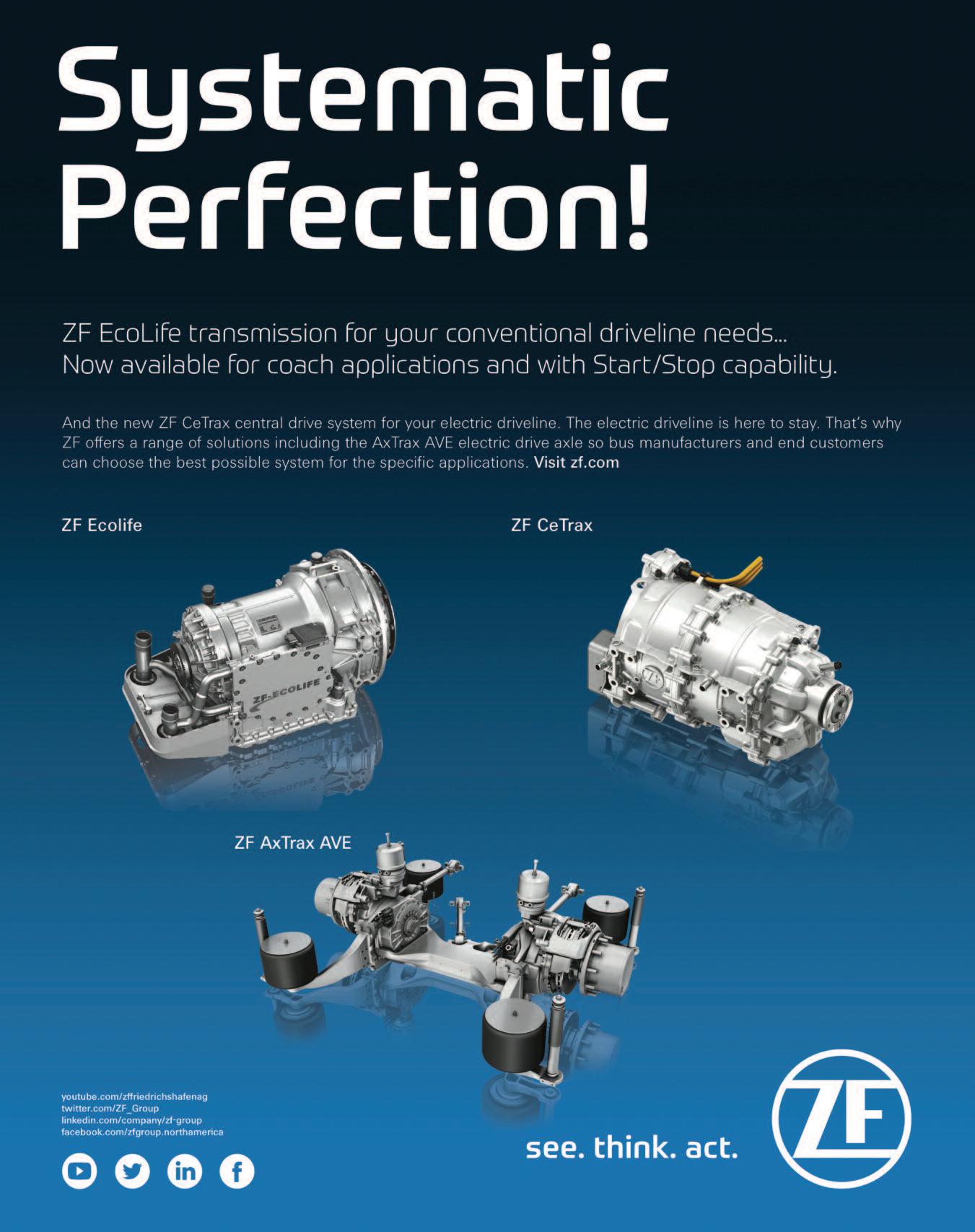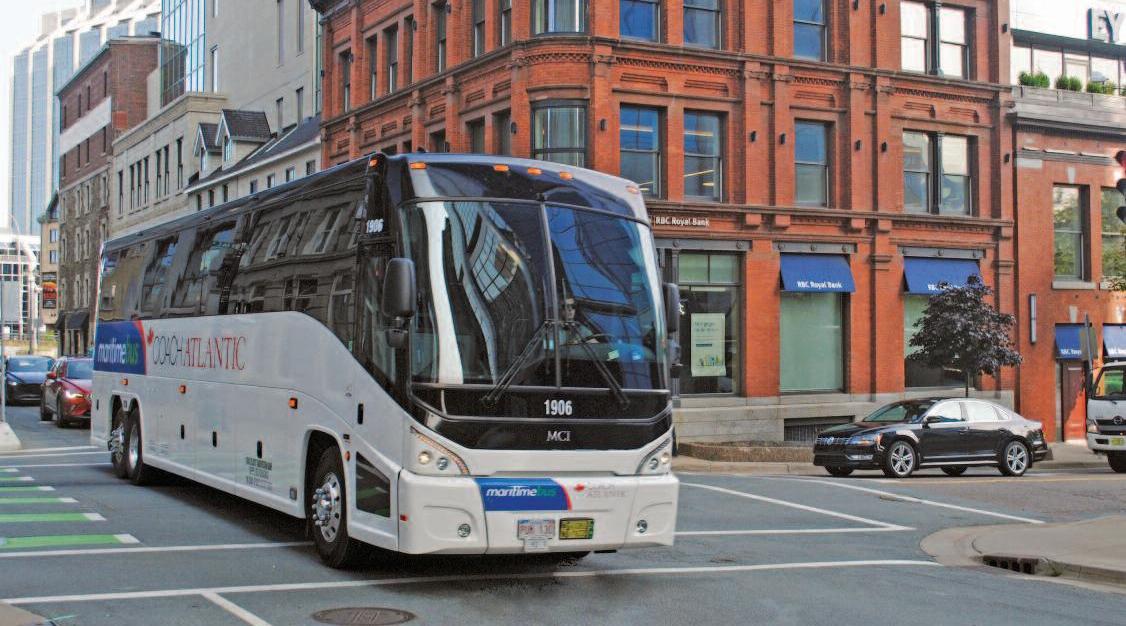
27 minute read
Bus Equipment People
from National Bus Trader The Magazine of Bus Equipment for the United States and Canada Vol XLIV, No. 3
Irizar USA
Irizar USA is very excited to introduce Patrick Laffan as the newest member of their team.
Advertisement
Laffan has been working for the motorcoach industry since 2003 and has a deep knowledge of the industry from both sales and technical aspects. He will be in the position of senior account executive and mostly serving the Northeastern United States.
Laffan joined
Keith is a 26-year motorcoach industry as the president of his neighborhood homeprofessional with a very wide and extensive owner’s association. knowledge of the industry and Southeastern United States. He will be in the position of Commercial Vehicle Safety Alliance senior account executive and provide sales Jake Elovirta joined the Commercial and support to the customers in the region Vehicle Safety Alliance (CVSA) on January and beyond. 4 as its new director of enforcement programs. He will be responsible for develStarting with Welch Industries and oping and managing the Alliance’s traffic Front-Line, Keith worked with them for 13 enforcement safety programs, projects years, starting as a technician, a super- and training. visor and then as manager. He then completed his Bachelor of Science in Business Elovirta will apply his more than 30 Administration, with a concentration in years of transportation safety experience operations management. He joined MCI to provide leadership, guidance and and worked with them for 14 years in var- direction to law enforcement personnel ious positions, the final position being the and the motor carrier industry on all director of service centers. His most aspects of commercial motor vehicle notable role there was a national director safety and traffic enforcement. the motorcoach of customer solutions. He now has joined industry as a Irizar USA and looks forward to being a “We’re pleased to welcome Jake to CVSA young man with part of the growing team. headquarters staff,” said CVSA Executive DATTCO, and then Patrick Laffan Director Collin Mooney. “As we continue to eventually moved Keith knows the industry very well and advance the goals of the Alliance, we are into bus sales. He has worked with different has built valuable local relationships through devoting even more resources to traffic manufacturers and dealerships, mostly the years. He is very familiar with the South- enforcement and public safety education recently with MCI and worked with them for eastern area and is initiatives. This new position further demonalmost four years. A Connecticut local, he well recognized strates our commitment to reducing roadway is very familiar with the region and has built and trusted. He deaths and injuries attributable to driver several strong relationships in his career. emphasizes on behaviors, the leading cause of crashes.” He has a very collaborative approach to supporting the sales and likes to engage with the cus- customers In addition to coordinating and managing tomers –on support and technical aspects throughout the the Alliance’s traffic enforcement safety inias well. He describes himself as being very sales and the after- tiatives, Elovirta will also manage CVSA’s dedicated, accessible and focuses on build- sales process. He Human Trafficking Enforcement program ing long-term relationships. He loves work- believes his loyalty, and the Operation Safe Driver program and ing in the motorcoach industry and the availability, dedica- its associated traffic safety awareness and involvement of family businesses that rep- tion and determi- enforcement initiative, Operation Safe Driver resent its modest nature. nation are some of Week. He will also develop and implement the key factors that commercial motor vehicle traffic enforce Having been very impressed with Irizar set him apart. Keith ment training programs and serve as the product line, Laffan is thrilled to be a part of has extensive primary contact and resource regarding a growing team and working with a product knowledge on the commercial motor vehicle enforcement that is new and exciting to the U.S. market. technical aspects as well and is very eager safety issues. He feels the values and organizational struc- to help his customers with any help they ture of Irizar are very interesting and res- might need. “I am happy to join the CVSA team,” said onate to his work beliefs. He will work not Elovirta. “As the new director of enforcement only in sales but help build deeper roots in Keith was very impressed with the Irizar programs, I will work to address the needs the region and develop the already existing product line and is very eager to be work- of the membership, advocate the positions sales network as well. The company ing with it. He is very elated to join the of the Alliance and advance CVSA’s mission, believes that Laffan will exceed the expec- company and believes that he will bring goals and strategic plan. I’ve spent my entire tations of its existing and potential customers the company closer to the customers in professional career devoted to transportain the area. the area. He will be working for the sales tion safety and I plan to continue that lifelong as well as the extension of the service net- commitment in this new role.”
Laffan resides in Connecticut with his work in the region. family and is an active volunteer in the com- Prior to joining CVSA, Elovirta spent 22 munity. He enjoys disc-golfing and partici- Keith was born and grew up in the South. years with the Vermont Department of Motor pating in leagues and tournaments. He lived briefly in Puerto Rico and Dominica Vehicle’s Enforcement and Safety Division. in his childhood as his parents were mis- He served as safety chief of the depart Irizar USA also announces the addition sionaries and now lives in central Florida ment’s Commercial Vehicle Enforcement of Kevin Keith to the team. with his family. He is a fitness enthusiast and Unit, then was appointed to colonel/director enjoys camping and boating. He also serves of the Enforcement and Safety Division. He
Kevin Keith
Bus Equipment People
retired in 2020 after a 32-year career in Vermont law enforcement.
Elovirta spent much of his law enforcement career focused on highway safety initiatives. He was Vermont’s first laser speed operator/instructor/trainer and is credited with having the first case law at the Vermont Judicial Bureau and Superior Court levels to accept the scientific reliability of laser speed determination devices for speed enforcement in Vermont.
Elovirta was a Level I commercial motor vehicle inspector, certified through CVSA. He also held a number of CVSA leadership positions, serving as the Region I president and vice president, as well as chair of the Information Systems Committee.
Elovirta earned a bachelor of arts degree in criminal justice from Norwich University and is a graduate of the FBI National Academy. He also completed the International Association of Chiefs of Police Leadership in Police Organization training program. q


by Larry Plachno

Photos by the author unless otherwise indicated
Taken as the sun was setting, this photo shows Big Ben, the Houses of Parliament and the River Thames in a classic London scene. The United Kingdom voted in 2016 to leave the European Union. It is a long story and the results could impact the bus industry to some extent.
Several readers are aware that your editor has been following the Brexit process for years. Hence, we have received several requests for a condensed report on Brexit as well as suggestions on how it will affect the bus industry. There already have been books written on Brexit so that trying to condense it into a thumbnail version will be difficult. In addition, since so much politics are involved, and there are so many sides to some of the issues, I have labeled this as “Editorial” since we are aware that there are many other opinions and views.
Geography
Agood place to start is with a little geography. The United Kingdom (UK) and Ireland are located on two islands west of Europe. Included in the United Kingdom are England, Scotland, Wales and Northern Ireland. The Island of Great Britain, located just west of the Netherlands, Belgium and France across the English channel has England on the south, Wales to the west and Scotland at the north. The neighboring Island of Ireland to the west is mainly the Republic of Ireland with Northern Ireland in the northeast corner. Up until 1922, both islands comprised the United Kingdom but Ireland broke away and became independent at that time.
Background
The UK had as much difficulty getting into the European Union (EU) and Common Market as it has getting out. The UK applied to join the European Economic Community, the predecessor of the EU, in 1963 and in 1967 but were vetoed by France. After Charles de Gaulle was no longer the French president, the UK was finally able to join on January 1, 1973.
To some extent the UK was somewhat of an uneasy member. On June 5, 1975, the UK voted on whether to remain in or leave the European Community and Common Market. This vote showed that 67 percent of the electorate wished to remain. In 1979, when the European Monetary System was created that led to developing the European Euro currency, the UK opted out. To this day the UK continues to use the Pound Sterling as its currency. It is the oldest currently in continuous use.
In more recent years, there has been an increase in euroskepticism in the UK. Some people were unhappy with economic conditions and EU regulations. Under the EU, fishing boats from various EU member states were allowed to fish in UK waters. Several sources suggest that a major factor was EU immigrants that came to the UK because of its social programs and then did not assimilate.
Things came to a head in 2016 when David Cameron and his conservatives won an overall majority in the 2015 UK election. They had made a commitment to hold a referendum on Britain’s involvement with the EU. Parliament complied by passing the necessary legislation for such a referendum. After several weeks of campaigning between the leavers and the remainers, voting took place on June 23, 2016. The result was that 52 percent of the electorate voted to leave the EU.
In retrospect it might be suggested that the reason for this outcome was that neither the UK nor the EU had taken steps to appease the voters who were unhappy with
For some, the result of the referendum was unexpected. Many of the UK elected officials had been on the remain side and were unhappy with the vote. There was talk of having another referendum in hope that the results would support remaining. But cooler heads eventually prevailed since a major decision like this could not brought up on a regular basis. However, things tended to move slowly in complying with the electorate and getting out of the EU.
Eight months went by before Prime Minister Theresa May took action under Article 50 on March 29, 2017 to indicate the UK’s intention to leave the EU. This initially gave the UK and EU two years (until March 29, 2019) to come up with an exit deal. But, again, things seemed to be delayed.
It was not until the early months of 2019 that Prime Minister Theresa May brought her suggested exit deal with the EU before Parliament. In spite of bending the law to bring it up three times, her deal with the EU was rejected by Parliament. As a result, the original deadline for Article 50 and departure were delayed twice.
Having been unable to make any progress with Brexit, Theresa May decided to resign as Prime Minister in July of 2019. Boris Johnson, a leader in the Leave campaign, took over as Prime Minister and extended the deadline for leaving the EU to January 31, 2020. Johnson called for an early general election in December where Johnson and his conservative Tory party won a majority of 80 seats in what was obviously a landslide and a mandate to get Brexit done.
I might interject that the flamboyant Boris Johnson had previously served as London’s mayor where he encouraged the traditional red double decker buses that began moving to hybrid and electric power. He also has a collection of model buses and an interest in transportation.
Two Major Problems
The UK officially left the EU on January 31, 2020 with some people celebrating in the streets. For the next 11 months the UK would be in a transition period where it still followed EU rules but was negotiating for a following trade agreement with the EU. There seemed to be two major problem areas.
The first of these problems is the only land border between the UK and other countries. This is the 310-mile border between Northern Ireland which is part of the UK, and Ireland, which is a member of the EU. In past years there have been conflicts in this area between the predominately Catholic residents of Ireland and the predominately Protestant residents of Northern Ireland. Various sources suggest that more than 3,000 died in what became known as “The Troubles. ” While the hostilities ended with what became called the Good Friday agreement of 1998, there has been reluctance to reinstate a formal border here.
What came about was a very awkward solution known as the backstop arrangement. A hard border would be eliminated by leaving Northern Ireland partially in the EU. The actual border would be the Irish Sea located between Northern Ireland and the other UK members of Scotland, Wales and England. None of the reporting I have seen talks about whether this kind of arrangement exists somewhere else. Among other things, it treats Northern Ireland differently than the other member states of the UK. At

The United Kingdom and Ireland are located on two islands west of Europe. England, Wales and Scotland are located on the eastern island while Ireland and Northern Ireland are on the western island. The only land border between the United Kingdom and another country is 310 miles between Northern Ireland and Ireland.
Prime Minister Boris Johnson and his conservative Tory party won a landslide election in December of 2019 that effectively was a mandate from the people to get Brexit done. This photo, taken a few years earlier, shows Boris Johnson driving a brand new red double-deck bus when he was the mayor of London. Johnson was responsible for getting modern red double-deck buses on London’s
streets. WRIGHTBUS.

The second major problem was the differences between the UK and EU in trying to work out a trade agreement following the split. The UK was adamant that they were leaving and wanted to be independent. The EU wanted to continue control in some areas. One EU concern was that the UK could subsidize certain industries to complete with similar EU industries. The EU wanted control over what the UK could support and what it could not. The UK, in turn, was faced with past inequalities, dealing with the pandemic, and a commitment to be independent. Another major stumbling block was that the EU wanted to control fishing in UK waters for EU fishing boats while the UK wanted to be independent and sovereign.
There were also suggestions from various sources that the EU was not going to give the UK a good deal on a trade agreement. Doing so could prompt other of the 27 EU member states to consider following the UK in departing. Italy has been unhappy over the EU’s treatment of their pandemic problem, Poland had concerns over their court system and other EU members may be thinking of leaving.
Hence, negotiations on the trade agreement with the EU were going down to the wire, December 31, 2020, when the UK would officially split with the EU. Lack of a trade agreement would require the UK and EU to operation on World Trade Organization rules. The UK was moving ahead with trade agreements with other countries.
In a scenario not unlike a cliffhanging action movie, the two sides reached an agreement on Christmas Eve, 2020, only a week prior to the actual split date. This prompted a mad scramble among the 27 EU states and the UK’s Parliament to take action to ease the split on December 31, 2020. The expected end result would be that commerce would continue across the English Chanel between the UK and EU with minimum fuss. And, the awkward position of Northern Ireland would be substantially improved. In addition, since the UK was now independent, it was expected that they would develop trade agreements with other countries.
The Bus Industry
How will Brexit impact the bus industry? I think that the best place to start out is by saying that bus operations in the UK, in Western Continental Europe and in the United States and Canada are substantially different. While all three have municipal bus operations, their long distance and suburban operations are different.
Western Europe had good public transportation with railroads and hence their long distance bus service has been geared primarily to tours. It has only been in recent years that there has been an increase in scheduled long distance buses. Distances are short (it is only 1,000 miles from London to Rome) so passenger amenities take presidence over vehicle longevity. Western Europe also has the advantage of numerous service locations at reasonable distances. With city transit, Europe is more prone to use railroad stations as hubs and terminals for city and suburban services.
The UK has even shorter distances. One joke that has a lot of truth is that you cannot drive more than a day east or west without getting your feet wet. Because of short distances, England is more likely to use bodyon-chassis buses than Europe or the United States. As in Europe, the body-on-chassis coaches are fairly good quality. While they have retained some of their rail service, it has been privatized and may have bus competition. In addition, much of the public transit services in the UK have also been privatized.
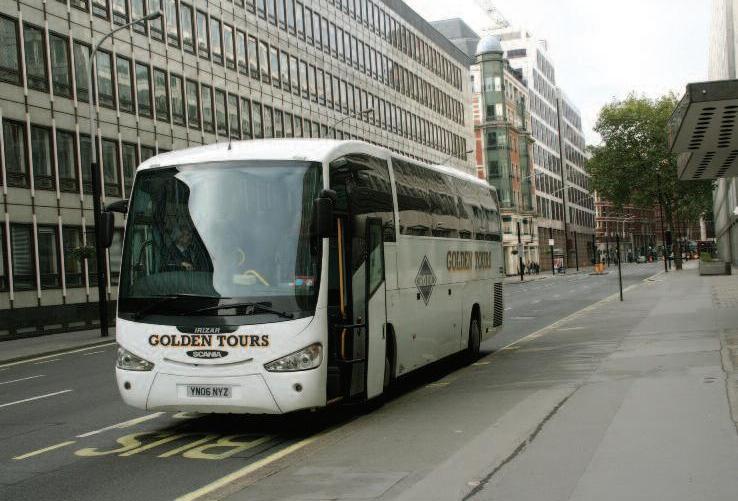
Higher quality body-on-chassis buses are popular in the UK for both charters and scheduled service. Shown here is a coach with an Irizar body on a Scania chassis. This particular combination was popular and served well.
Bus operators in the UK will sometimes order integral coaches from Continental Europe for heavyduty route service. This three-axle Van Hool from Belgium was operating on a route for Greenline and was photographed leaving the Victoria bus station. Van Hool does a brisk business in exports to several countries and even offers right-hand drive for UK operators.

Bus service in the United States and Canada grew up around scheduled service and residual value has been important. Hence, American buses traditionally are higher quality integral with substantial longevity. Our city transit operations do not put as much effort into railroad station connections and hubs as they do in Europe.
Based on my past experience, the major imports from the EU to the UK have been higher quality body-on-chassis and integral coaches used primarily for tours and heavy scheduled service. Scania coaches with Irizar bodies were very popular in England in the past. Van Hool offers coaches with right hand drive for the British market. Some of the other European builders also offer modifications for the UK operators.
Because of the last-minute trade agreement, it would be expected that trade between the EU and UK will continue much as previously. This means that higher quality body-on-chassis and integral coaches will be sold by EU builders into the UK.
What will probably change is increased trade between the UK and other countries. The UK has already been making its own trade deals with several other countries. This will probably be positive for Alexander Dennis, the affiliate of New Flyer and MCI. Alexander Dennis is most likely already the leading British bus exporter and Brexit will increase trade arrangements with other countries will most likely give them additional locations to sell their buses.
I might add that Brexit will probably bring the UK and United States closer for trade. I would not be surprised to see more UK products being exported to the United States in the future. q
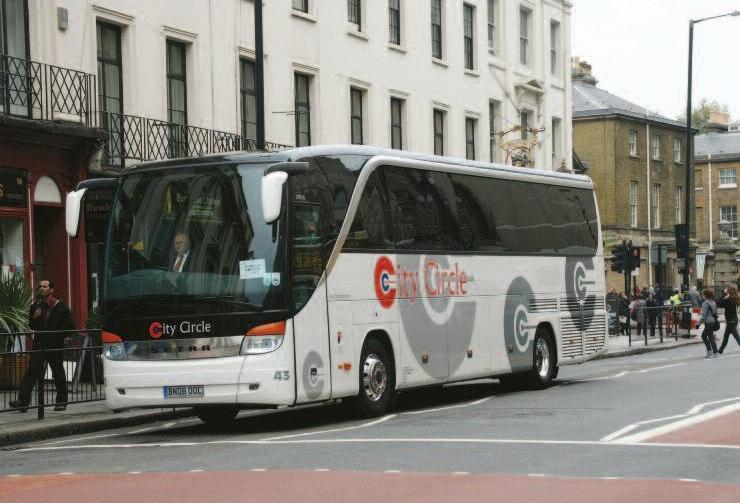
Another integral coach found in the UK is the Setra from Germany. This two-axle model was built with right-hand drive for the UK. It was being used on a city tourism route in London.

Cruising a tropical reef, our dive guide signaled that someone should check out a hole in the coral, so we could see what was hiding there. It may surprise you, but I am not that goofy (besides, the guide was not sticking his face in).
Trusting him, a young woman gave it a whirl, and screamed mightily as a small octopus shot out of the hole. Honest – you can hear screams underwater. One of the great things about diving is that, if terror makes you wet your pants, no one knows. Turns out the guide had no idea what was hiding in there, but was willing to risk her to find out.
If he moved to the mainland, he would have great potential as bureaucrat. The public often trusts them to guide business along the straight and narrow, and they are willing to make us try all sorts of things in pursuit of safety. Sometimes those things work . . . and sometimes they do not, but they are never at risk. We should trust them because they know best.
In 1974, regulators mandated expensive antilock brakes on commercial vehicles, and then forced us to disable them because they were actually causing accidents. Years later, technology improved, the regulation came back and arguably has worked well.
A recent article in a trade magazine pointed out that hours-of-service (HOS) violations have dropped by 50 percent since enforcement of the ELD mandate began. Unfortunately, there has been no corresponding improvement in actual safety; in fact accidents have slightly increased. Some observers think aggressive driving to beat the arbitrary gadget may be part of that.
Gee whiz, could it be that half of past HOS violations were safety irrelevant silliness like spelling errors, failure to sign the logbook or my personal favorite: napping in the wrong bus? Those generally are not issues with an ELD.
All that money spent, with no discernible benefit. What the heck, it was not the regulator’s money. The meaning here is not that regulation is bad. Some is worthwhile, and some silliness, but there is no incentive on the part of bureaucrats to get it right the first time, because they have no significant skin in the game.
A real question is whether the crushing regulatory burden imposed has actually improved commercial vehicle safety – or (pun intended) driven people into their cars, where they can be casualties that do not befoul the regulators cherished statistics.
A couple of points here. While they feel empowered to tell us what to do, their political cousins like transit authorities are not forced to play by the same rules. Gee whiz, they are the well intentioned government, so what could go wrong?
Ask New York subway riders or MBTA Red line riders, or NJT commuter rail riders. When we screw up we pay, when they screw up they ask for more money. If we do not give it to them, their foul-ups are our fault. In real life we are beholden only to our clientele, while they serve political constituencies, unions and bureaucracy in addition to their relatively captive customers.
As regulators of the private sector pursue the mythical beast of safety perfection, it is worth asking if the saintly public sector does as well.
Second, while in my view often naive, these folks are well intended. When we are offered the chance to comment on pending legislation or regulation, we need to shine
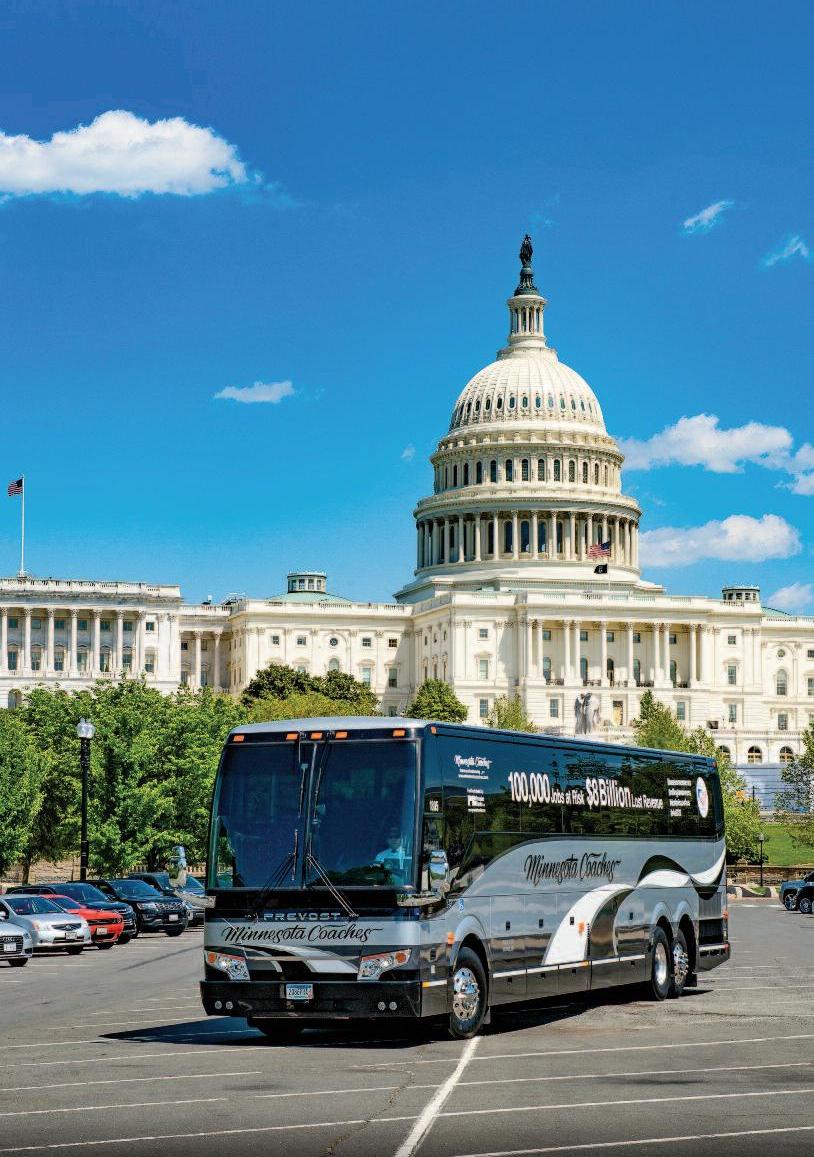
The Unexpected Octopus
Something that regulators could learn from
by Dave Millhouser
Like finding an unexpected octopus in an underground cave, some government rules and regulations may have unexpected results. For example, since electronic logging devices have been required in buses there has not been an obvious increase in safety. This delightful photo showing the Capitol in Washington was taken by Barry Howell from Minnesota Coaches and shows one of his Prevosts.
BARRY HOWELL.
Drivers Test Skills at 2020 UMA International Driver Competition
Article and photos by Mark Szyperski
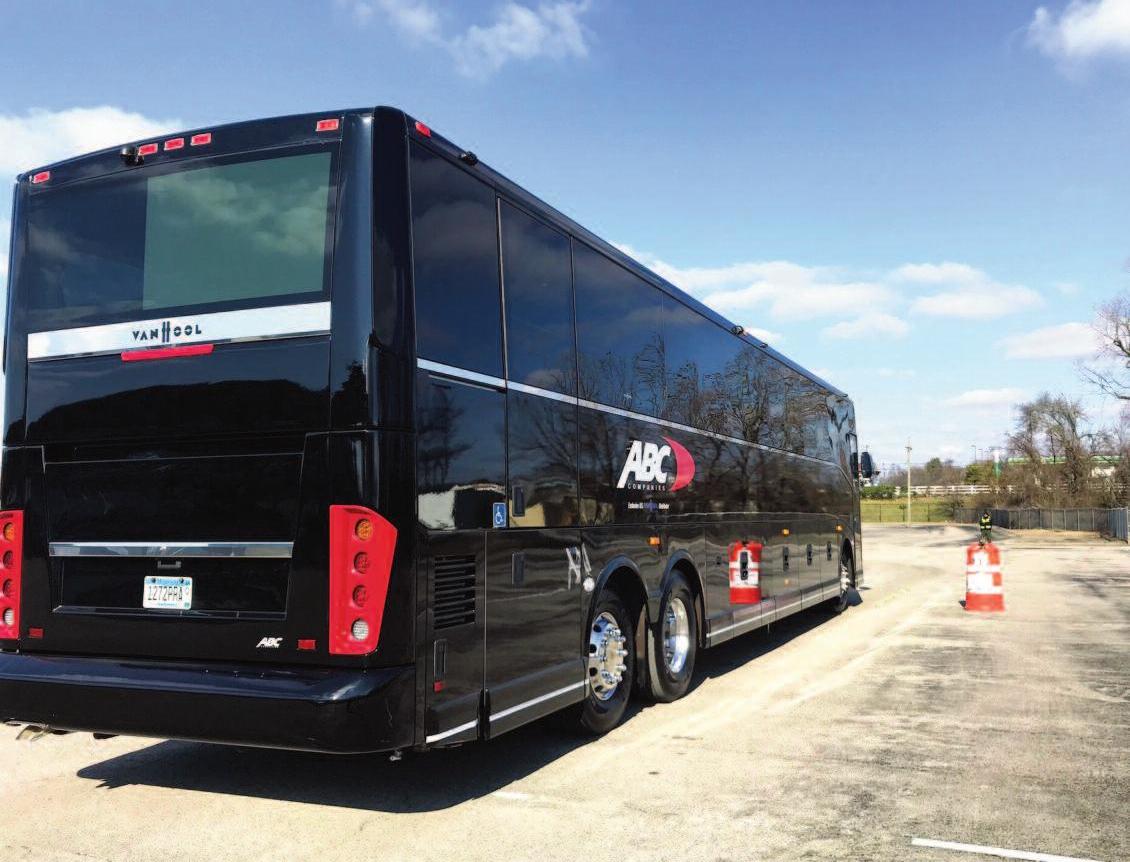
Drivers for bus companies all around the United States and Canada tested their skills at the recent 2020 UMA International Driving Competition. In addition to actual driving skills, the drivers take a written exam and are monitored by onboard judges. Some drivers won cash awards for their driving skills while all participants were given the United Motorcoach Association “Excellence in Driving” award.
Inches to spare, seconds ticking, sweat beading. No, this is not a new action movie, it is the Fourth Annual UMA International Driver Competition, presented by the United Motorcoach Association (UMA).
This year’s competition was held during the 2020 UMA Motorcoach Expo in Nashville, Tennessee. Twenty-seven drivers from around the United States and Canada competed for cash prizes and recognition to be one of the industry’s top skilled drivers. This year’s Grand Champion, Wren Nance, is a motorcoach driver with Northeast Charters and Tours in Lewiston, Maine. Along with bragging rights, Nance took home a check for $2,500. Other winners included First Runner-up Henry Jensen, from Premier Transportation in Knoxville, Tennessee ($1,000), and Second Runner-up Steve Erickson, Escot Bus Lines, Largo/Orlando ($500). The competition commences when the operators first apply. Drivers are required to have a violation-free driving record and no preventable crashes in the past two years. All drivers qualifying for the competition are presented with the United Motorcoach Association “Excellence in Driving” award. Upon arrival at the UMA Motorcoach Expo, the competition begins when drivers submit to a written exam, testing their knowledge of the Federal Motor Carrier Safety Regula-
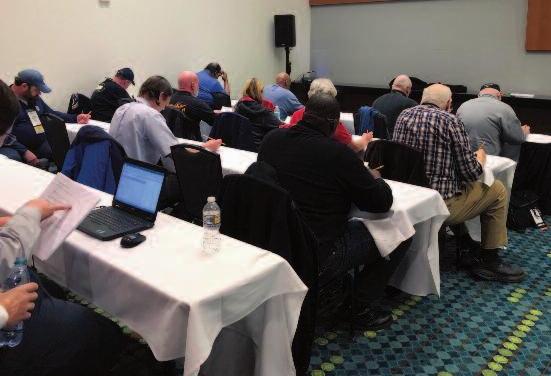
The first day of the competition starts with a written exam. This tests their knowledge of the Federal Motor Carrier Safety Regulations including drug and alcohol regulations, basic pre-trip questions and driving regulations. Krapf Coaches of West Chester, Pennsylvania graciously donated cones, barrels, stanchions and associated equipment along with a new trailer to haul everything. This equipment will be available for other competitions.
ABC Companies/Van Hool, Motor Coach Industries, Prevost and Temsa all provided coaches for the driving test. When lined up for the actual driving test, drivers were required to take the next coach in line. There were several tests in the course itself including a “diminishing lane, ” the “offset alley, ” “turning skills” and other challenges.
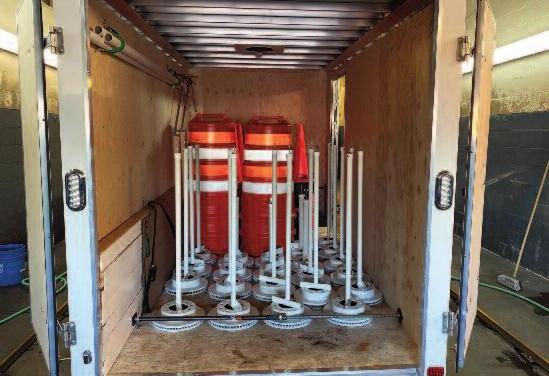
tions as it pertains to requirements in areas such as drug and alcohol regulations, basic pre-trip questions and driving regulations. There also a few requirements pertaining to drivers regarding Americans with Disabilities regulations. Afterwards, drivers are invited to join the opening reception at Expo.
Day 2 began with a confidence building breakfast, a few last-minute instructions and a quick shuttle to the test range located this year at Gaylord Opryland Resort & Convention Center where seven skill stations awaited. Upon arrival, drivers do a walkthrough of the course. Drivers were challenged by “diminishing lane, ” the “offset alley, ” “alley docking” and progressing to “alley docking, ” “turning skills, ” “serpentine” and “parallel park” and finally the “stop line. ”
Along with scores for each skill station, each driver was evaluated by an onboard judge. Judges observed how the driver followed directions, their demeanor though the skill stations and other factors, including keeping a stopwatch running during the driving portion. Although each operator is timed from start to stop line, the time logged driving through the skill stations only applies in the event of a rare tie.
An important component of the competition is drivers draw numbers for their starting position and compete driving the next coach in the rotation. Most often drivers find themselves driving an unfamiliar coach. Even if the coach is a make and model they may be familiar with, the competition coaches are all the latest models. While waiting their turn to drive the course, drivers participate in a class that reviews the questions and answers to the previous day ’s written exam. Drivers consistently give this session high praise.
Ken Presley, vice president of legislative and regulatory affairs and industry relations/COO, is in charge of the entire event each year. He has overseen the program since its inception and has set the system. “We find this is an excellent way for companies to provide both training and rewarding great drivers for their excellent skills, ” stated Presley. “Many drivers arrive here by being winners of their state/regional association or employer-held driver competition, ” he continued, “so, this becomes a multi-level contest for many. ”
Also, a part of the driver competition since its inception has been the associates of On Your Mark Transportation, LLC from Nashville, Tennessee. Over the years, On Your Mark Transportation has assisted Presley at multiple levels beginning months before the competition. “It truly has been an honor to assist Ken and the United Motorcoach Association with this project every year, ” stated Mark Szyperski, president and CEO of On Your Mark Transportation. “We are always amazed at the professionalism and skill level exhibited by these top motorcoach drivers” he stated.
“The On Your Mark Transportation team and Johnny Cauley (Jean’s Buses, Greenville, South Carolina) have been with us from day one, ” said Presley. “There is a lot of coordination and logistics that go into an event of this scale. Frankly, we could not do it without them. ”
This year, assistance also arrived in the form of a welcomed gift from Krapf Coaches (West Chester, Pennsylvania). Krapf Coaches donated cones, barrels,

Twenty-seven bus drivers from around the United States and Canada participated in the 2020 UMA International Driver Competition. Motorcoach companies that would like to participate in future events can run their own company driver competition or consider sending drivers to state or regional competitions. Information on future events is available from Ken Presley at UMA.

stanchions and assorted equipment along with a new trailer to haul everything. “We won’t have to go scratching, begging and borrowing for cones and barrels to conduct future driver competitions,” said Presley. “A special thank you to Buddy Sload at Krapf.” Sload, director of operations at Krapf, supervised the equipment project and personally fabricated some of the equipment. Presley commented, “Our hope is that other competitions will take advantage of the equipment for their competitions.”
The event begins at least a year in advance, securing a site suitable for the competition, arranging hotel rooms, catering, drafting volunteers and soliciting sponsors. “It takes a small army to pull this event off,” said Presley. “The competition requires multiple skill station judges, on-board judges, runners, along with individuals totaling the multiple scores. We are so appreciative of each and every judge that donates his time to assist making the event a success.”
Sponsors make the event financially feasible. Continuing their commitment to the motorcoach driver profession, Prevost is the signature sponsor of the event. Lancer Insurance Company has co-sponsored the event for a number of years, and this year the AMBEST family of travel plazas joined as a sponsor. Kerri Wirachowsky of the Commercial Vehicle Safety Alliance assisted the competition by arranging a team of Tennessee State Patrol Troopers to volunteer as judges. A motorcoach driver competition would not be complete without motorcoaches. ABC Companies/Van Hool, Motor Coach Industries, Prevost and Temsa all loaned coaches for the competition.
It is never too early for motorcoach companies to consider having their own driver competition or sending drivers to their state or regional association competition; often the qualifying process for sending a driver to next year’s national competition.
Plans are well underway for this year’s 2021 UMA International Motorcoach Driver Competition in Orlando, Florida. Watch for more details or contact UMA’s Presley at KPresley@uma.org. q

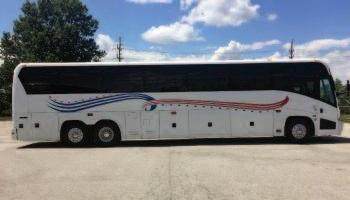
2005 MCI J4500 Detroit / Allison - 515,817 miles - $45,000 OBO
•Well maintained 56-pass coach • Comfortable high-back reclining seats •Large tinted windows • Enclosed overhead interior compartments •Restroom •Power outlets and USB ports •Large underbody luggage compartments •TV Monitors/DVD/Stereo •Interior PA system •Located in St. Louis
Contact Lynn at (314) 750-6172 or LSansone9@gmailcom
MOVING?
Please let us know at least 60 days in advance to ensure that your next issue of NATIONALBUS TRADER reaches your new address. Postcards with changeof-address forms are available at your local post office.



